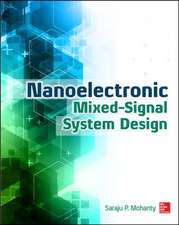Programming the Propeller with Spin: A Beginner's Guide to Parallel Processing
Autor Harprit Sandhuen Limba Engleză Paperback – 16 aug 2010
Publisher's Note: Products purchased from Third Party sellers are not guaranteed by the publisher for quality, authenticity, or access to any online entitlements included with the product.
Parallel Processing With the Propeller--Made Easy!
"This book should find a place on any Propellerhead's bookshelf, between Parallax's Propeller Manual and its Programming and Customizing the Multicore Propeller volumes." Make: 24Programming the Propeller with Spin: A Beginner's Guide to Parallel Processing walks you through the essential skills you need to build and control devices using the Propeller chip and its parallel processing environment. Find out how to use each of the identical 32-bit processors, known as cogs, and make the eight cogs effectively interact with each other. The book covers Propeller hardware and software setup, memory, and the Spin language. Step-by-step projects give you hands-on experience as you learn how to:
- Use Propeller I/O techniques with extensive Spin code examples
- Display numbers with seven segment displays
- Create accurate, controlled pulse sequences
- Add a 16 character by two line LCO display
- Control R/C hobby servos
- Use motor amplifiers to control small motors
- Run a bipolar stepper motor
- Build a gravity sensor-based auto-leveling table
- Run DC motors with incremental encoders
- Run small AC motors
"This book should find a place on any Propellerhead's bookshelf, between Parallax's Propeller Manual and its Programming and Customizing the Multicore Propeller volumes." Make: 24
Preț: 230.10 lei
Preț vechi: 327.76 lei
-30% Nou
Puncte Express: 345
Preț estimativ în valută:
44.03€ • 47.08$ • 36.71£
44.03€ • 47.08$ • 36.71£
Carte tipărită la comandă
Livrare economică 18-23 aprilie
Preluare comenzi: 021 569.72.76
Specificații
ISBN-13: 9780071716666
ISBN-10: 0071716661
Pagini: 368
Dimensiuni: 185 x 231 x 19 mm
Greutate: 0.64 kg
Editura: McGraw Hill Education
Colecția McGraw Hill TAB
Locul publicării:United States
ISBN-10: 0071716661
Pagini: 368
Dimensiuni: 185 x 231 x 19 mm
Greutate: 0.64 kg
Editura: McGraw Hill Education
Colecția McGraw Hill TAB
Locul publicării:United States
Cuprins
Preface
Part I: The Propeller/SPIN System. Introduction for the Beginner; Chapter 1. A General Introduction to the Propeller Chip; Chapter 2. The Propeller Chip. An Overall Description; Chapter 3. The Hardware Setup; Chapter 4. Software Setup: The Propeller "Tool" Environment; Chapter 5. The Various Propeller Memories; Chapter 6. The How and Why of Shared Memory; Chapter 7. Understanding One Cog; Chapter 8. The Eight Cogs; Chapter 9. Special Terms and Ideas; Chapter 10. The Spin Language; Chapter 11. Tasks Suited to Parallel Processing; Part II: Input and Output: The Basic Techniques to Be Mastered--Learning by Doing; Chapter 12. General Discussion of Input/Output; Chapter 13. Binary Pulsing; Chapter 14. Setting Up a 16-Character-by-2-Line Liquid Crystal Display; Chapter 15. Binary Input and Output: Reading a Switch and Turning on an LED if Switch is Closed; Chapter 16. Reading a Potentiometer: Creating an Input We Can Vary in Real Time; Chapter 17. Creating and Reading Frequencies; Chapter 18. Reading and Creating Pulses; Part III: The Projects: Using What Was Learned to Build The Projects; Chapter 19. Seven Segment Displays: Displaying Numbers with Seven-Segment LED Displays; Chapter 20. The Metronomes; Chapter 21. Understanding a 16-Character-by-2-Line LCD Display; Chapter 22. Running Motors: A Preliminary Discussion; Chapter 23. Motor Amplifiers for Small Motors; Chapter 24. Motor Amplifiers for Small Motors; Chapter 25. Controlling a Small DC Motor; Chapter 26. Running a Stepper Motor: Bipolar, Four-Wire Motors; Chapter 27. Gravity Sensor Based Auto-Leveling Table; Chapter 28. Running DC Motors with Attached Incremental Encoders; Chapter 29. Running Small AC Motors: Controlling Inductive Loads; Part IV: Appendixes; Appendix A. LCDRoutines4 and Utilities Object Listings; Appendix B. Materials; Appendix C. Turning Cogs On and Off; Appendix D. Experiments Board; Appendix E. Debugging; Epilogue; Index
Part I: The Propeller/SPIN System. Introduction for the Beginner; Chapter 1. A General Introduction to the Propeller Chip; Chapter 2. The Propeller Chip. An Overall Description; Chapter 3. The Hardware Setup; Chapter 4. Software Setup: The Propeller "Tool" Environment; Chapter 5. The Various Propeller Memories; Chapter 6. The How and Why of Shared Memory; Chapter 7. Understanding One Cog; Chapter 8. The Eight Cogs; Chapter 9. Special Terms and Ideas; Chapter 10. The Spin Language; Chapter 11. Tasks Suited to Parallel Processing; Part II: Input and Output: The Basic Techniques to Be Mastered--Learning by Doing; Chapter 12. General Discussion of Input/Output; Chapter 13. Binary Pulsing; Chapter 14. Setting Up a 16-Character-by-2-Line Liquid Crystal Display; Chapter 15. Binary Input and Output: Reading a Switch and Turning on an LED if Switch is Closed; Chapter 16. Reading a Potentiometer: Creating an Input We Can Vary in Real Time; Chapter 17. Creating and Reading Frequencies; Chapter 18. Reading and Creating Pulses; Part III: The Projects: Using What Was Learned to Build The Projects; Chapter 19. Seven Segment Displays: Displaying Numbers with Seven-Segment LED Displays; Chapter 20. The Metronomes; Chapter 21. Understanding a 16-Character-by-2-Line LCD Display; Chapter 22. Running Motors: A Preliminary Discussion; Chapter 23. Motor Amplifiers for Small Motors; Chapter 24. Motor Amplifiers for Small Motors; Chapter 25. Controlling a Small DC Motor; Chapter 26. Running a Stepper Motor: Bipolar, Four-Wire Motors; Chapter 27. Gravity Sensor Based Auto-Leveling Table; Chapter 28. Running DC Motors with Attached Incremental Encoders; Chapter 29. Running Small AC Motors: Controlling Inductive Loads; Part IV: Appendixes; Appendix A. LCDRoutines4 and Utilities Object Listings; Appendix B. Materials; Appendix C. Turning Cogs On and Off; Appendix D. Experiments Board; Appendix E. Debugging; Epilogue; Index















